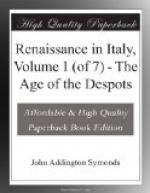During the anarchy of Italy between 1494—the date of the invasion of Charles VIII.—and 1527—the date of the sack of Rome—the voice of preaching friars and hermits was often raised, and the effect was always to drive the people to a frenzy of revivalistic piety. Milan was the center of the military operations of the French, the Swiss, the Spaniards, and the Germans. No city suffered more cruelly, and in none were fanatical prophets received with greater superstition. In 1516 there appeared in Milan ’a layman, large of stature, gaunt, and beyond measure wild, without shoes, without shirt, bareheaded, with bristly hair and beard, and so thin that he seemed another Julian the hermit.’ He lived on water and millet-seed, slept on the bare earth, refused alms of all sorts, and preached with wonderful authority. In spite of the opposition of the Archbishop and the Chapter, he chose the Duomo for his theater; and there he denounced the vices of the priests and monks to vast congregations of eager listeners. In a word, he engaged in open warfare with the clergy on their own ground. But they of course proved too strong for him, and he was driven out of the city. He was a native of Siena, aged 30.[1] We may compare with this picturesque apparition of Jeronimo in Milan what Varchi says about the prophets who haunted Rome like birds of evil omen in the first years of the pontificate of Clement VII. ’Not only friars from the pulpit, but hermits on the piazza, went about preaching and predicting the ruin of Italy and the end of the world with wild cries and threats.’[2] In 1523 Milan beheld the spectacle of a parody of the old preachers. There appeared a certain Frate di S. Marco, whom the people held for a saint, and who ’encouraged the Milanese against the French, saying it was a merit with Jesus Christ to slay those Frenchmen, and that they were pigs.’ He seems to have been a feeble and ignorant fellow, whose head had been turned by the examples of Bussolaro and Savonarola.[3] Again, in 1529, we find a certain monk, Tommaso, of the order of S. Dominic, stirring up a great commotion of piety in Milan. The city had been brought to the very lowest state of misery by the Spanish occupation; and, strange to say, this friar was himself a Spaniard. In order to propitiate offended deities, he organized a procession on a great scale. 700 women, 500 men, and 2,500 children assembled in the cathedral. The children were dressed in white, the men and women in sackcloth, and all were barefooted. They promenaded the streets of Milan, incessantly shouting Misericordia! and besieged the Duomo with the same dismal cry, the Bishop and the Municipal authorities of Milan taking part in the devotion.[4] These gusts of penitential piety were matters of real national importance. Writers imbued with the classic spirit of the Renaissance thought them worthy of a place in their philosophical histories. Thus we find Pitti, in the Storia Fiorentina (Arch.




